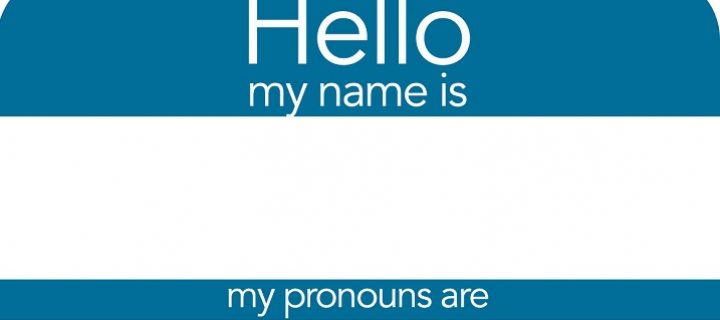In role-play, players and their characters do not always use the same pronouns. Some players use role-play to explore personal questions of gender identity, using the alibi of the character to give them a chance to try on a new identity and experience being known, seen, and referred to as that gender. Others are simply more interested in experiencing a particular game from the point of view of a gender that is not their own, often because they desire the challenge of the play, or because they feel that the roles of a specific gender are more intriguing or important. Others still are gender non-conforming in some way and experience misgendering in and out of games.
More and more larpers are coming out as transgender — meaning that their gender is different from what they were assigned at birth — or non-binary, in which their gender doesn’t fit within the gender binary of male or female. As a result, the way larps and larp communities use pronouns, casting, and references to gender role-play also needs to adapt in order for a larp to be accessible and inclusive to participants of any gender. Terms like “cross-play,” which has typically meant to play the opposite of your own gender become problematized when moving beyond a gender binary. Casting based on what gender one presents as or passes as, instead of what gender one wishes to play is also something to question, and can sometimes feel at odds with the design goals of the larp or the ideals of immersion.

“Grammar Wars #2: ‘Never Assume Someone’s Pronouns’” by David Bleasdale on Flickr. (CC BY 2.0).
These important considerations are beyond the scope of this article, though, which deals solely with player and character pronoun markers and the introduction of a pronoun correction mechanic to use at larps. These tools are designed to allow players to ensure their pronouns are known and used for themselves off-game and for the characters they are playing. The goal is to minimize the amount of misgendering, to expose participants to the variety of gender identities people may hold, to create the norm that pronouns matter, and to implement a procedure for correcting a pronoun mistake. All of these are in place to establish a Culture of Care and Trust, as well as to make our games and communities safer and more inclusive spaces for all bodies, genders, and identities.
Pronouns matter. Misgendering someone is a big deal that causes them discomfort and pain. A misgendered player experiences immersion breaks in their role-play at best and gender dysphoria at worst. Misgendering contributes to negative bleed and emotional distress. Assuming pronouns for a player or a character can lead to trouble. To avoid pronoun assumption, the triggering effects of misgendering, and the sometimes difficult process of correcting a misused pronoun, the following pronoun statement and correction mechanics were developed. They were created in 2016 for New World Magischola by Maury Brown, Sarah Lynne Bowman and Harrison Greene, with help from Sara Williamson and Liz Gorinsky, co-authors of the larp See Me Now, which explores queer identities. Brodie Atwater contributed to later workshop adaptations. Pronoun markers are now in use in several large larps and larp conventions, and the pronoun correction mechanic is in use at Learn Larp, Event Horizon, and Double Exposure events.
Pronouns on Display: Two Methods
There are two main procedures regarding using pronouns on name badges at larps or conventions. The first approach displays pronouns on all name badges as an expectation or norm; and the second allows participants to add their pronouns to badges (or wear a separate badge or patch) if they choose. In both cases, players designate their own pronouns, and upon seeing the displayed pronoun, other members of the community are expected to make every effort to refer to each person by the pronoun that they have displayed.
Default Pronoun Listing and Default Gender-Inclusive Pronoun
New World Magischola (2016-) and Event Horizon (2017-) display player pronouns on player badges and character pronouns on character badges as a default. Players are asked to list their preferred pronouns on the document or database prior to the game, and nametags are printed from that source. The expectation set by this choice is that pronouns matter and cannot be assumed. Participants check the nametag to give all co-players the courtesy of correctly gendering them. In the absence of knowing someone’s personal pronouns, the default pronoun is “they,” which may be corrected to another pronoun using the procedure below or by checking the name badge.

Badge for a professor in New World Magischola with pronouns. Photo by Learn Larp, LLC.
Putting preferred pronouns on all nametags normalizes listing pronouns. This practice recognizes their importance for player safety and inclusion, and makes it a generally accepted practice to see them for everyone, not just those folks who are gender non-conforming. It brings awareness to the existence of other ways of identifying and includes those who identify beyond the gender binary. If pronoun markers are a choice, it can single out those who choose to wear the badge, and draw attention to them as different from the “norm” or somehow “needing” a badge more than someone else. It can also be more difficult for a trans participant to have to decide whether to make their pronoun choice explicit (sometimes outing themselves), or attempt to pass by deciding whether to use a pronoun badge. Such a practice can make them feel that they are different from the rest of the community by needing to wear one, since their presenting gender may not “adequately conform” to their preferred identity. When pronouns are listed by default, it removes this decision from any participant, as it’s just a matter of course that all participants’ pronouns will be visibly stated. All players display their pronouns on player nametags and all characters display their pronouns on character nametags. The font is large enough to be seen at a conversational distance.
Separate Pronoun Badges or Patches
The large networked North American post-apocalyptic boffer campaign Dystopia Rising added pronoun patches in late 2016 and the Polish-Danish perennial castle larp College of Wizardry added pronoun badges in 2017. Badges and patches are a way for players to self-select displaying their pronouns on their in-game costumes or off-game attire. DR made official patches that are sold through their company store, and made rules about wearing them to ensure that subcultures in their game network could not discriminate against them or ban their use. In addition, the singular design would be recognized across their many-game network, and the guidelines for displaying them helped to universalize where to look. Prior to creating their official badges, some players had been making their own, or writing pronouns on another part of their costume, and there had been dissension in the community about whether this was proper. The official patches were intended to end those arguments. She/her, he/him, and they/them patches exist.

Dystopia Rising’s pronoun patches. Photo courtesy of Eschaton Media Productions.
In their fall 2016 and spring 2017 games, College of Wizardry introduced pin-on buttons/badges, which they made available for free at the beginning of the larp, as players pick up their robes and ties. The badges have three choices of pronoun options available (He/Him, She/Her, and They/Them) and they are optional to wear and use. These 1” badges are generally pinned near the name badge and are in a font that is easily readable. While primarily intended for use in-game, some players also use them at the after-party as well, especially if their off-game gender differs from their in-game one. Many College of Wizardry students wear various badges already — such as a House crest pin, or a pin to show support for an activist cause or membership in a club — so the use of a pin-on badge makes sense in the world.
In both cases of Dystopia Rising and College of Wizardry, any player may choose to wear a badge, but no player is required to do so. Some cis players choose to wear one to bring awareness to pronouns and help normalize their use in game. Some players, including trans and nonbinary players, do not want to make their pronouns explicit, so they choose not to wear a badge. Trans and nonbinary players have noted that this self-selection process can require them to out themselves in a way that may not be safe or desired. Some genderfluid players do not want to choose a specific pronoun, so they may choose to wear two or more of the badges. In either game there is no mechanic for a default pronoun. Players in both communities have expressed thanks that the patches and badges were introduced and used.
Pros and Cons
In either method of pronoun marker, it is important that the stated and enforced community norm be that a participant’s stated gender is accepted at face value and without question. Comments such as, “it’s difficult for me to call you [pronoun] because you so clearly look like [gender]” are harassing, unwelcome, and should not be tolerated.
Not every game will want to use a name badge for characters in-game, or use pronoun markers of any kind. An immersive historical larp where everyone is in period costumes, for example, may find the name badges or pronoun badges to be disruptive to immersion. If you are using name badges, placing the pronouns on the badge itself is typically least disruptive, as there is only one article that is “out of place” on the Regency ball gown or the pirate couture, for example. Organizers should make a careful and calculated decision about using name badges and/or pronoun badges. They are weighing player comfort and safety against an immersion ideal. Whatever choice is made, they will have to justify it to themselves and their participants. Choosing not to include visible pronouns may make certain participants feel uncomfortable, especially if they worry about being repeatedly misgendered, which can disrupt their own immersion.

College of Wizardry pronoun pins. Photo courtesy of Dziobak Larp Studios.
Listing pronouns on name tags as a default is not the same as mandating wearing a separate pronoun badge or ribbon. Separate badges are extra items to wear or attach, and requiring everyone to add them begs the question of “but what if I don’t need one, because my presentation is obvious” or “I don’t want these progressive politics introduced into my game” or “adding the badge breaks my immersion.” Leaving them as an option can create these conversations and invite these arguments, which can be difficult for genderqueer participants to hear and be part of. Making pronouns a part of a regular nametag normalizes them as an essential piece of information, not an option, and stops deliberation about whether they should be used. This practice also raises awareness for correct pronoun usage outside of the larp.
However, sometimes the act of choosing, especially for a genderfluid person, creates discomfort. The design choice of having the default gender neutral pronoun, “they” can reduce that concern, as “they” is used if a pronoun is not indicated. Using “they” signals a lack of reliance on the gender binary, as “they” is neither expressly male or female. Without the default pronoun of “they” participants tend to fall back on the binary, which is already normalized. The default of “they” instead changes the norm, but allows gender binary pronouns to co-exist within it.
Correcting a Pronoun Mistake
Being misgendered is a big deal, and it should not be tolerated. Many people who use incorrect pronouns do so despite good intentions and are genuinely mortified when they make a mistake. While being misgendered causes negative and hurtful feelings and is in some cases used as a form of deliberate harm, aggression, or violence toward trans and nonbinary people, when seeking to create a safety tool to contribute to a culture of care and trust, it is important that all participants give each other the benefit of the doubt. The benefit of the doubt means that everyone in the community will do their very best to use each person’s correct pronouns, and that there is a shared responsibility for correcting someone who makes a pronoun mistake, promptly and matter-of-factly.

A name and pronouns sticker from the Human Rights Campaign. “2017.06.08 Pride DC People and Places, Washington DC USA 6108” by Ted Eytan on Flickr. (CC BY-SA 2.0).
When a person is corrected, they should accept it graciously, thank the person who is helping them use the proper pronoun, and treat their co-players with respect. The overriding principle is: “If you make a mistake and use the wrong pronouns in spite of your good intentions, the best response is to acknowledge the mistake, correct, and continue the conversation.” Over-apologizing exaggerates the mistake, derails the role-play and makes both the person who was misgendered and the person who did the misgendering uncomfortable. This situation can lead the person who was misgendered to feel compelled to reassure the player who made the mistake, which can heighten feelings of dysphoria or alienation. Thus, a simple “thank you” is considered preferred etiquette and is least anxiety-producing for everyone involved.
To enact this norm, the following pronoun correction procedure was created and implemented in New World Magischola beginning in June 2016. A similar procedure is used at Event Horizon larp and at Double Exposure conventions (DREAMATION, DEXCON, and Metatopia). Providing a mechanic that includes a script both normalizes and standardizes the correction. This makes it second-nature and ensures that a considerate correction/response is used and expected.
Pronoun Correction Procedure
If a misgendering occurs, participants are taught and expected use the following quick, non-judgmental pronoun correction mechanic. This technique is used for both in-game and off-game interactions:
- Person 1 accidentally uses the incorrect pronoun to refer to someone. The person who was misgendered can be the person you are speaking to or someone you are speaking about.
- Person 2 notices the incorrect pronoun use and says the word “Pronouns” and shows the P hand signal. This can be one of two signals: the British sign language symbol for the letter P (which requires two hands) or the American Sign Language symbol for P (right hand only). If the player does not have one or both hands available, or chooses to, they can simply use the verbal cue “Pronouns.”
- Person 2 follows the verbal cue and/or hand signal with the correct pronoun for Player 1 to use. e.g. “Pronouns. They.”
- Person 1 says “Thank you” for the reminder and repeats the correct pronoun. Play or conversation resumes.

The British sign language symbol for P. Photo by british-sign.co.uk.
Person 1: “We were leaving class at the same time, but I didn’t get a chance to talk to her.”
Person 2: [Makes a P symbol] “Pronouns. They.”
Person 1: “Thank you. I didn’t get the chance to talk to them.”
This procedure can be repeated as often as necessary if the misgendering continues. Sometimes it is genuinely difficult to change one’s speech habits and use a different pronoun, especially when one is already under the cognitive load of roleplay. A person may need several reminders. The expectation is that one is corrected each time, both to help someone pay attention to their language use, and to encourage not letting a misgendering pass without correction. Anyone who notices the pronoun mistake is encouraged to speak up; it can be much easier for a friend to correct on behalf of someone misgendered than the person themselves. In each case, the response is the same: the person correcting uses the mechanic and states the correct pronoun and the person being corrected acknowledges with “thank you” and repeating the pronoun. Needing several reminders can be frustrating for everyone, but repetition is often needed as people learn new habits. If it appears that someone is intentionally misgendering or refusing to abide by stated pronouns, an organizer or member of the safety team should become involved. Deliberate misgendering or dismissal of the importance of using a person’s preferred pronouns is harassment and should be dealt with accordingly.

American Sign Language symbol for P. Photo courtesy of Pixabay.
What the Mechanic Does and Its Usefulness
- Sends a clear message that your community is inclusive to people of all genders.
- Formalizes how pronouns are handled in your community.
- Reduces the amount of misgendering that occurs for players and characters.
- Gives a simple and quick correction procedure that is expected and minimally intrusive.
- Opens community members’ eyes to perspectives beyond a gender binary.
- Teaches participants how to get better at recognizing and using different pronouns.
- Helps trans and nonbinary participants feel more respected and safer.
- Allows role-play to continue quickly after a correction, rather than allowing a conversation to derail into obsequies and discomfort.
- Shares the responsibility for ensuring people are called by their proper pronouns to everyone in the community, not just those who use gender binary conforming pronouns.
- Opens your game to multiple gender expressions.

Pronoun Pins for XOXO Art and Technology Festival in Portland, Oregon. “Gender Recognition Pins” by sarahmirk on Wikimedia Commons. (CC BY-SA 4.0).
Conclusion
Pronouns markers and gender in games are a topic that needs further study in larp communities. Trans and gender-noncomforming players have stated that having a method for indicating and correcting their pronouns makes them feel more welcomed and included. Having one’s pronouns respected helps players feel safe and able to trust their fellow participants. Implementing a pronoun correction mechanic shares the responsibility for ensuring that correct pronouns are used with everyone in the community. Trans and gender-nonconforming participants have stated that it can be exhausting and difficult to continually correct others themselves, and that they appreciate it when others correct and advocate for proper pronoun use on their behalf. Many larpers and people in general society have little experience with people who identify beyond the gender binary, and tend to default to language or behavior that often is harmful to genderqueer co-players. Designers and organizers can put tools and techniques such as these in place to improve awareness of how default gender norms marginalize nonbinary and trans participants; to take steps to improve marginalization and toxic behavior within game communities; and to model better behaviors outside of the gamespace. While these tools do not solve the systemic issues that trans, nonbinary, and genderqueer people face in larps and everyday life, they make a visible and important step toward inclusion.
Special thanks to Alex Rowland, Brodie Atwater, and Dani Higgins for feedback on early versions of this article.
References
Bowman, Sarah Lynne. “Bleed: The Spillover Between Player and Character. March 2, 2015. https://nordiclarp.org/2015/03/02/bleed-the-spillover-between-player-and-character/
Brown, Maury. “Creating a Culture of Trust through Safety and Calibration Larp Mechanics.” September 9, 2016. https://nordiclarp.org/2016/09/09/creating-culture-trust-safety-calibration-larp-mechanics/
Cover Photo: “2016.07.01 Nametags with Pronouns – Avery 5392_nonbranded” by Ted Eytan on Flickr. (CC BY-SA 2.0). Photo has been cropped.






